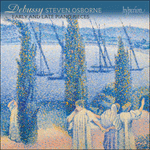Debussy's last piece from 1890, or thereabouts, originally bore another exotic title:
Tarantelle styrienne, watered down in the 1903 reprint to ‘Danse’. Catherine Kautsky points out that ‘“Tarentisme”, or the involuntary and obsessive dancing of the tarentella, was another of the hysteria diagnoses most in vogue in the late 1800s’. She also describes the music as ‘one of those exceptional Debussy pieces that gallops to a fortissimo, bravura ending, making no apologies for its blazing and unnuanced convictions’. In 1922 Ravel orchestrated it, no doubt attracted also by the hemiola rhythms (six quavers variously grouped as 3 x 2 and 2 x 3), which he turned to again in the first song of his
Don Quichotte à Dulcinée.
from notes by Roger Nichols © 2022
La dernière pièce composée vers 1890 de Debussy portait, à l’origine, un autre titre exotique:
Tarantelle styrienne, baptisée «Danse» dans la réédition de 1903. Catherine Kautsky souligne que le «“Tarentisme”, ou la façon involontaire et obsessionnelle de danser la tarentelle, était un autre des diagnostiques de l’hystérie très en vogue à la fin du XIXe siècle». Elle décrit aussi la musique comme «l’une de ces pièces exceptionnelles de Debussy qui galope jusqu’à une conclusion de bravoure fortissimo, sans chercher à excuser ses convictions enflammées et dépourvues de nuances». En 1922, Ravel l’orchestra, sans doute également attiré par ses rythmes en hémioles (six croches qui ne sont pas toujours regroupées de la même manière, comme 3 x 2 et 2 x 3), qu’il utilisa à nouveau dans la première mélodie de
Don Quichotte à Dulcinée.
extrait des notes rédigées par Roger Nichols © 2022
Français: Marie-Stella Pâris
Debussys letztes Stück von etwa 1890 trug ursprünglich einen anderen exotischen Titel:
Tarantelle styrienne, was in der Neuauflage von 1903 zu „Danse“ abgemildert wurde. Catherine Kautsky weist darauf hin, dass der „Tarentisme“, oder das unfreiwillige und zwanghafte Tanzen der Tarentella, eine weitere Hysterie-Diagnose war, die Ende des 19. Jahrhunderts sehr en vogue waren. Sie beschreibt die Musik zudem als „eines jener außergewöhnlichen Debussy-Stücke, die auf ein bravouröses Ende im Fortissimo hin galoppieren, ohne sich für ihre flammenden und unausgewogenen Überzeugungen zu rechtfertigen“. 1922 orchestrierte Ravel das Werk, zweifellos auch fasziniert von den Hemiolen-Rhythmen (sechs Achtelnoten, die wechselnd als 3 x 2 und 2 x 3 gruppiert sind), die er im ersten Lied seines
Don Quichotte à Dulcinée wieder aufgriff.
aus dem Begleittext von Roger Nichols © 2022
Deutsch: Viola Scheffel


 Debussy: Early and late piano pieces
Debussy: Early and late piano pieces
